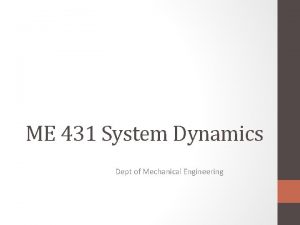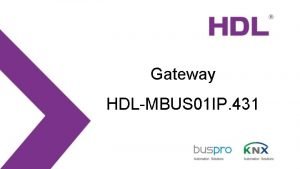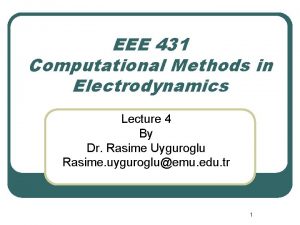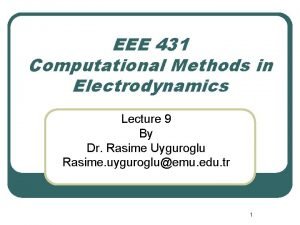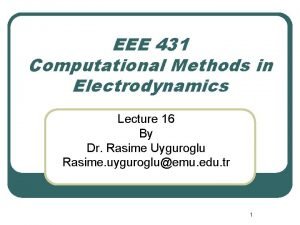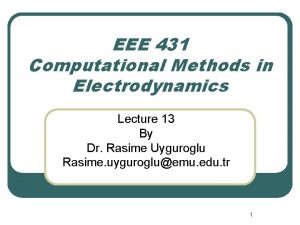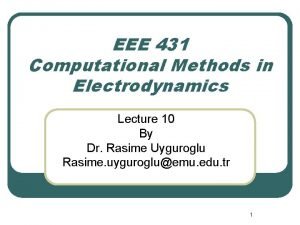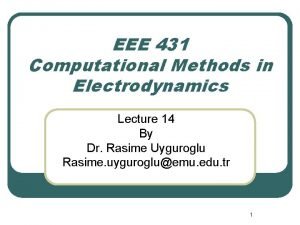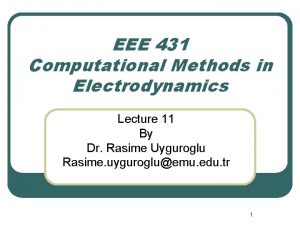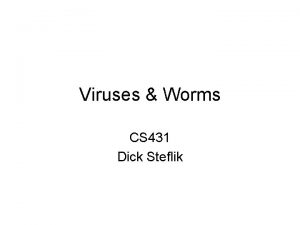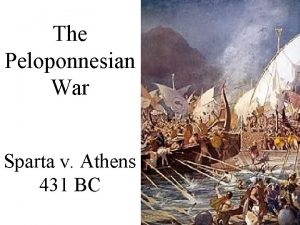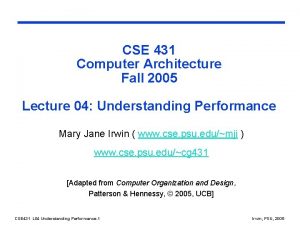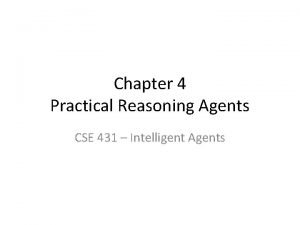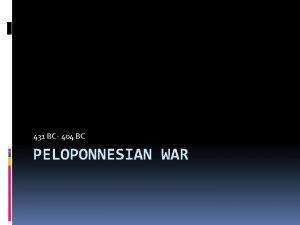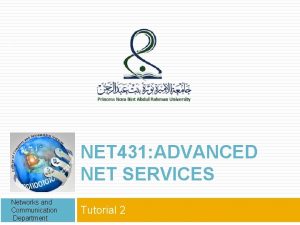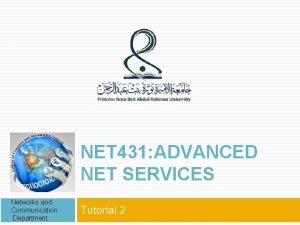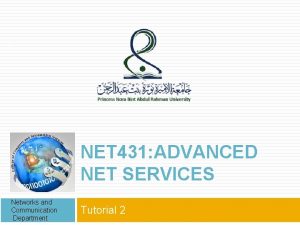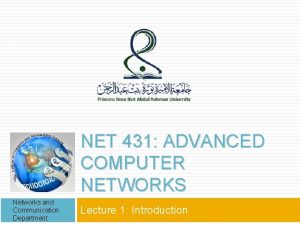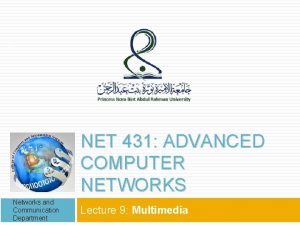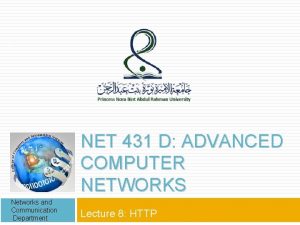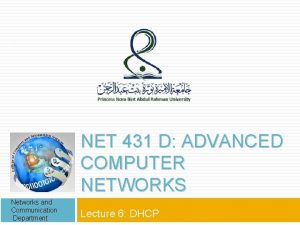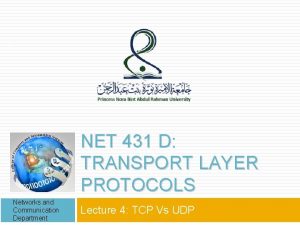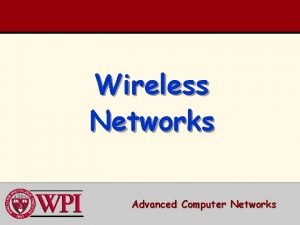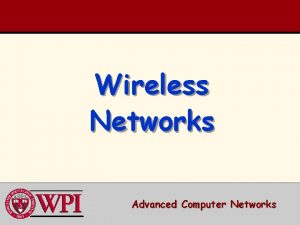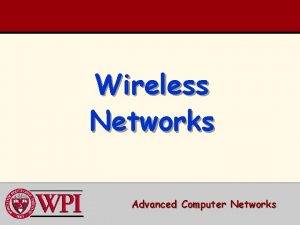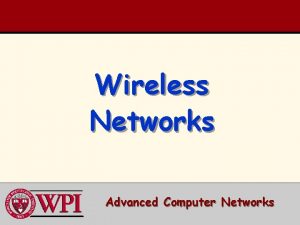1 NET 431 ADVANCED NET SERVICES Networks and



















- Slides: 19

1 NET 431: ADVANCED NET SERVICES Networks and Communication Department Tutorial 1

2 Q 1: What are the concerns of the physical layer in the Internet model? physical characteristics of the media representation of bits type of encoding synchronization of bits transmission rate and mode the way devices are connected with each other and to the links 22 -Nov-20 Networks and Communication Department

3 Q 2: What are the responsibilities of the data link layer in the Internet model? framing data bits providing the physical addresses of the sender/receiver data rate control detection and correction of damaged and lost frames 22 -Nov-20 Networks and Communication Department

4 Q 3: What is the difference between a port address, a logical address, and a physical address? The physical address is the local address of a node; it is used by the data link layer to deliver data from one node to another within the same network. The logical address defines the sender and receiver at the network layer and is used to deliver messages across multiple networks. The port address (servicepoint) identifies the application process on the station. 22 -Nov-20 Networks and Communication Department

5 Q 4: In Figure, computer A sends a message to computer D via LANl, router Rl, and LAN 2. assume that the communication is between a process running at computer A with port address i and a process running at computer D with port address j. Show the contents of packets and frames at the network, data link, and transport layer for each hop. 22 -Nov-20 Networks and Communication Department

6 22 -Nov-20 Networks and Communication Department

7 Q 5: If the data link layer can detect errors between hops, why do you think we need another checking mechanism at the transport layer? The errors between the nodes can be detected by the data link layer control, but the error at the node (between input port and output port) of the node cannot be detected by the data link layer. 22 -Nov-20 Networks and Communication Department

8 Q 6: In a block of addresses, we know the IP address of one host is 25. 34. 12. 56/16. What are the first address (network address) and the last address and number of address in the block? 22 -Nov-20 Networks and Communication Department

9 The number of address 2^(32 -16)=2^(16)= 65, 536 address 22 -Nov-20 Networks and Communication Department

10 Q 7: Calculate the HLEN (in IPv 4) value if the total length is 1200 bytes, 1176 of which is data from the upper layer. Header Length = Total Length - Data Length = 1200 − 1176 = 24 HLEN = 24/4 = 6 (in decimal) → 0110 (in binary) 22 -Nov-20 Networks and Communication Department

11 Q 8: In an IPv 4 datagram, the M bit is 0, the value of HLEN is 5, the value of total length is 200, and the offset value is 200. What is the number of the first byte and number of the last byte in this datagram? Is this the last fragment, the first fragment, or a middle fragment? Data size = 200 − (5 × 4) = 180 bytes First byte= 200 × 8 = 1600 The number of the last byte = First byte value + data size − 1 = 1779 M = 0, offset ≠ 0 → last fragment 22 -Nov-20 Networks and Communication Department

Q 9: What is a protocol ? A protocol is the set of rules or conventions governing the way in which two entities cooperate to exchange data.

13 Q 10: What is a Packet Data Unit (PDU) ?

14 A PDU is the combination of data from the next higher communications layer and control information. 22 -Nov-20 Networks and Communication Department

15 Q 11: What are some advantages to layering as seen in the TCP/IP reference model Layering decomposes the overall communications problem into a number of more manageable sub problems. 22 -Nov-20 Networks and Communication Department

16 Q 12: Compare the TCP header and the UDP header. List the fields in the TCP header that are missing from UDP header. Give the reason for their absence. 22 -Nov-20 Networks and Communication Department

17 Q 13: The following is a dump of a UDP header in hexadecimal format. 0632000 DOO l. CE 217 a. What is the source port number? b. What is the destination port number? c. What is the total length of the user datagram? d. What is the length of the data? 22 -Nov-20 Networks and Communication Department

18 a. Port number 1586 b. Port number 13 c. 28 bytes d. 20 bytes (28 – 8 byte header) 22 -Nov-20 Networks and Communication Department

19 Q&A 22 -Nov-20 Networks and Communication Department



